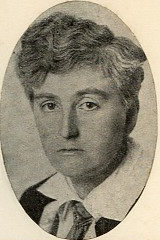Fembio Specials Famous Lesbians Elsa von Bonin
Fembio Special: Famous Lesbians
Elsa von Bonin

(Dr. iur. Elsa Jutta Rosalie von Bonin, Elsa von Bonin-Brettin)
born on October 14, 1882 in Berlin, the German Empire
died on June 17, 1965 in Berlin, West Germany
German writer and lawyer
60th anniversary of her death on June 17, 2025
Biography
Elsa von Bonin, the youngest of three sisters, was born in Berlin on October 14, 1882. Her parents were Gisbert von Bonin, a royal Prussian chamberlain, landowner and administrative lawyer, and Maria von Bonin, née Baroness von Hurter.
She received private tutoring in preparation for her school-leaving examination, which she passed at a grammar school in Jena that specialized in the classical humanities. She then studied law in Jena and Berlin, writing her dissertation on the applicability of the motive in substantive criminal law and receiving her doctorate from the law faculty in Greifswald in 1917.
She was particularly fond of Brettin, and she chose to acquire the family manor from the estate the three sisters had jointly inherited following the death of their parents in 1912/13. Half of the 2,000-acre estate was farmed, and half was used for forestry and hunting. Initially she leased the lands out, but after she took over the management herself, the business improved markedly – due entirely, according to her son, to “her wisdom and the expertise she had acquired.” She also attended to all the hunting and forestry issues herself.
In 1905, Elsa von Bonin had an affair with the writer Toni Schwabe, who left the writer Sophie Hoechstetter for Elsa. She met Dr. Erna Schill-Krämer, the daughter of a Rhenish factory owner, while they were both still students. The couple lived in Brettin together after Elsa acquired it and Erna took over the management of the household. Among their friends – all women of “high intellectual and artistic caliber” – was the sculptor Milly Steger, who modeled Bonin's head in clay at the estate.
Already in 1911, Elsa von Bonin published a novel about the childhood and youth of a noblewoman in turn-of-the-century Berlin that was clearly autobiographical: the heroine in Das Leben der Renée von Catte rejects the conventional role accorded to women and finds fulfillment in a lesbian relationship. Reprinted in a facsimile edition by Daphne Verlag in 1985, the novel was published several years before the most well-known lesbian novel of the time, Der Skorpion (The Scorpion). Yet the three volumes in Anna Elisabet Weirauch’s series, published starting in 1919, were much more popular than Elsa von Bonin’s earlier novel.
Two more novels followed, with Borwin Lüdekings Kampf mit Gott receiving first prize in a fiction competition organized by the Hamburger Fremdenblatt and the Münchener Neueste Nachrichten in 1926. Elsa von Bonin was awarded 50,000 Reichsmarks – a considerable sum at the time.
Even though she generally lived rather frugally, she still enjoyed treating herself to educational trips, for example to Italy and Egypt.
In 1933, she adopted a neighborhood boy who had lost his father at an early age. Fabian von Ostau was 12 years old when he became her son and heir.
The Prussian conservatives rejected National Socialism as “proletarian,” and she too made no secret of her disdain. She did not publish anything during the Nazi era. After the Russians marched into Germany in 1945, she remained on her estate until she was forced to leave it due to the “land reform,” i.e. expropriation. However, she refused to leave voluntarily; feigning poor health, she had to be carried out.
After stays in Magdeburg and Erfurt, she spent the last years of her life together with Erna Schill-Krämer in West Berlin. She lived on royalties from her literary works and on income from previously acquired stocks.
Elsa von Bonin died in 1965, Erna Schill-Krämer in 1972. The two women are buried together in a shared urn grave.
(Text from 2015; translated with DeepL.com; edited by Ramona Fararo, 2025.
Please consult the German version for additional information, pictures, sources, videos, and bibliography.)
Author: Doris Hermanns
Quotes
Elsa v. Bonin dressed mainly in well-made tailored suits with a mid-length skirt; her hair was parted, wavy and cut short at the nape of the neck. She wore round hats with a hunting touch, as worn by many ladies in the countryside. (Fabian von Bonin – von Ostau)
Since she was rarely inclined to compromise, she occasionally appeared somewhat brusque, which often led to her fundamentally sensitive and caring nature being misunderstood. (Fabian von Bonin – von Ostau)
If you hold the rights to one or more of the images on this page and object to its/their appearance here, please contact Fembio.


